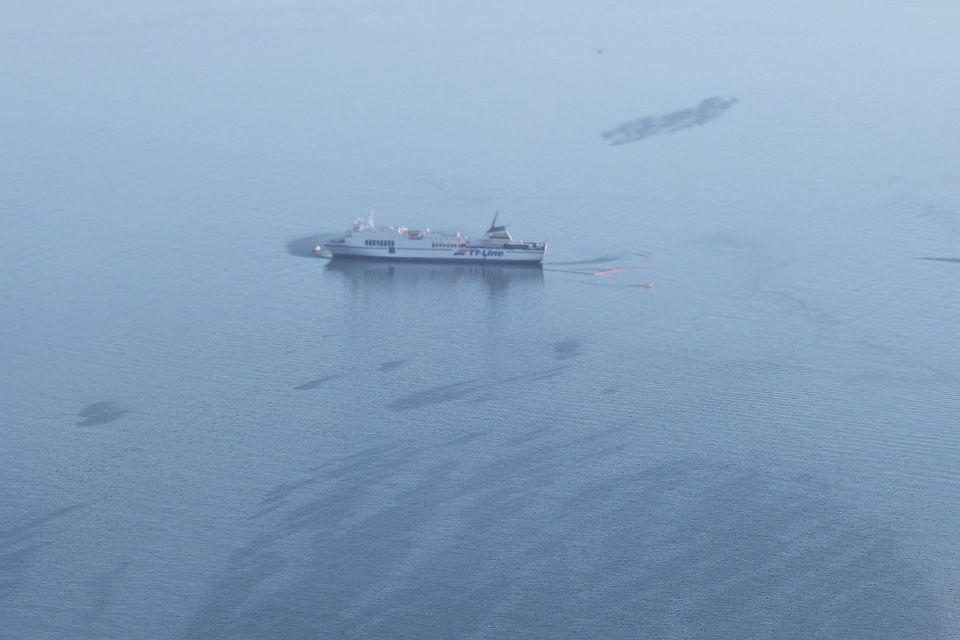Although a start has been made with removing oil from the tanks of the grounded ferry Marco Polo on Saturday, more oil leaked from the vessel on Sunday. Due to heavy weather at the site at that time, the ferry drifted off the ground and then ran aground again.
On Saturday afternoon, 28 October, shipping company TT-Line reported that at noon time, the second phase of the salvage operation was started. With the tugboat Max assisting, the shallow draught bunker vessel Tresfjord went alongside the Marco Polo. Using specialised equipment to reach the remaining bunker, the operation of pumping out the fuel oil from the breached tank was started shortly after 2pm.

However, on Sunday, the weather deteriorated, so it is unclear at the moment how much oil has indeed been removed from the vessel so far. Due to the weather, the Marco Polo drifted off the ground and then ran aground again. Under the direction of the Swedish Maritime Administration’s Maritime and Air Rescue Centre (JRCC), some of the crew were evacuated on Sunday afternoon.
Also read: Oil spill in Sweden after ferry grounds, Smit called in for salvage
New oil spill
The movement of the vessel, has resulted in more oil being spilled. According to the Swedish Coast Guard, the ship has suffered serious damage, including water ingress into the damaged oil tanks.
On Sunday afternoon, the Coast Guard aircraft could see oil in the sea which was drifting towards Norje in Pukaviksbukten and Karlshamn, Blekinge. The Coast Guard’s shore organisation has been reinforced over the weekend with fifty people from the Home Guard and Swedish Coast Guard trainees.
More protective equipment is also being sent to the base at Hörvik in Blekinge, as well as, for example, lighting to be able to work in the dark. Due to a constantly changing wind direction, oil can drift up onto other beaches in the vicinity.
In addition, two oil trawlers borrowed from the European Maritime Safety Agency (EMSA) have been launched for testing and training. The oil trawlers are intended to be used to recover oil that has sunk below the surface of the water where it cannot be seen or cleaned up with the Swedish Coast Guard’s own oil recovery system.
It is currently unknown how much oil has been released. 300 cubic metres of oil are estimated to remain in the ferry Marco Polo’s tanks. The Coast Guard has so far recovered 30 cubic metres of oil and oil waste.
Salvage plan
A salvage plan was submitted to the Coast Guard and the Swedish Transport Agency on Saturday. TT-Line has contracted Smit Salvage to carry out the salvage. The salvage plan will be analysed and must be approved before the actual salvage work can begin.
According to TT-Line, the removal of oil from the tanks is the second phase of the salvage plan, after the vessel was stabilised (the first phase). The third phase is the refloating and recovery operation. It is as yet unclear, however, how or when these phases will continue now that the ship drifted from its position in bad weather on Sunday and subsequently grounded again.
Also read: Swedish Coast Guard orders new patrol vessels from Damen
Marco Polo grounding
At 7 am on Sunday 22 October, TT-line’s passenger ferry Marco Polo ran aground south of Karlshamn, in Pukaviksbukten, Sweden. The 75 passengers and crew were unharmed, but both oil and diesel have leaked into the sea. According to the Swedish Coast Guard, the vessel grounded twice. After the first grounding it sailed on while leaking oil for several nautical miles before grounding again later and remaining stuck there.
On 25 October, two crew members of the Marco Polo were charged with negligence in maritime traffic. The Coast Guard’s criminal investigation has shown that there is probable cause to suspect a criminal offence against two crew members who acted recklessly in connection with the two groundings.
Picture (top): The passenger ferry Marco Polo, which ran aground, has caused an oil and diesel spill in the sea along the coast near Hörvik, Blekinge (by the Swedish Coast Guard).
Also read: Swedish Coast Guard detects palm oil spill and traces it to tanker








